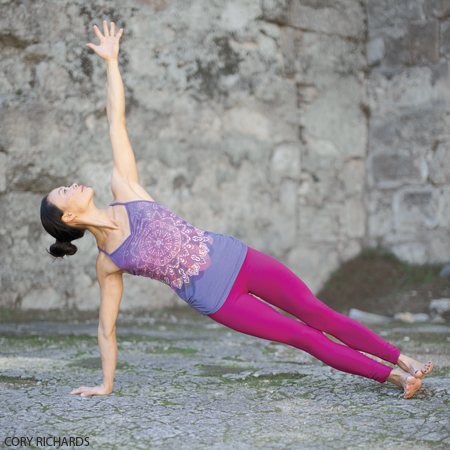The full version of Vasisthasana, as taught by BKS Iyengar, with the top leg raised perpendicular to the floor, is beyond the capacity of most beginners. The pose described here is a modified version suitable for all levels of students.
(vah-sish-TAHS-anna)
Vasistha = literally means “most excellent, best, richest.†Vasistha is the name of several well-known sages in the yoga tradition. There’s a Vasistha numbered among the seven (sometimes 10 or 12) seers (rishis) or lords of creation (prajapatis), and a Vasistha who’s author of a number of Vedic hymns. He’s also said to be the owner of the fabulous “cow of plenty,†Nandini (“delightâ€), which grants his every wish and accounts for his infinite wealth.
Side Plank Pose: Step-by-Step Instructions

Perform Adho Mukha Svanasana. Shift onto the outside edge of your left foot, and stack your right foot on top of the left. Now swing your right hand onto your right hip, turn your torso to the right as you do, and support the weight of your body on the outer left foot and left hand.
See also More Arm Balance Poses

Make sure that the supporting hand isn’t directly below its shoulder; position the hand slightly in front of its shoulder, so the supporting arm is angled a bit relative to the floor. Straighten the arm by firming the triceps muscle, and press the base of the index finger firmly against the floor.
See also More Core Yoga Poses

Firm the scapulas and sacrum against the back torso. Strengthen the thighs, and press through the heels toward the floor. Align your entire body into one long diagonal line from the heels to the crown.
See also Balancing Poses

If you’d like you can stretch the top arm toward the ceiling, parallel to the line of the shoulders. Keep the head in a neutral position, or turn it to gaze up at the top hand.
See also Four Poses for a More Mindful Yoga Practice

Stay in this position for 15 to 30 seconds. Come back to Adho Mukha Svanasana, take a few breaths, and repeat to the right side for the same length of time. Then return to Adho Mukha Svanasana for a few more breaths, and finally release into Balasana.
